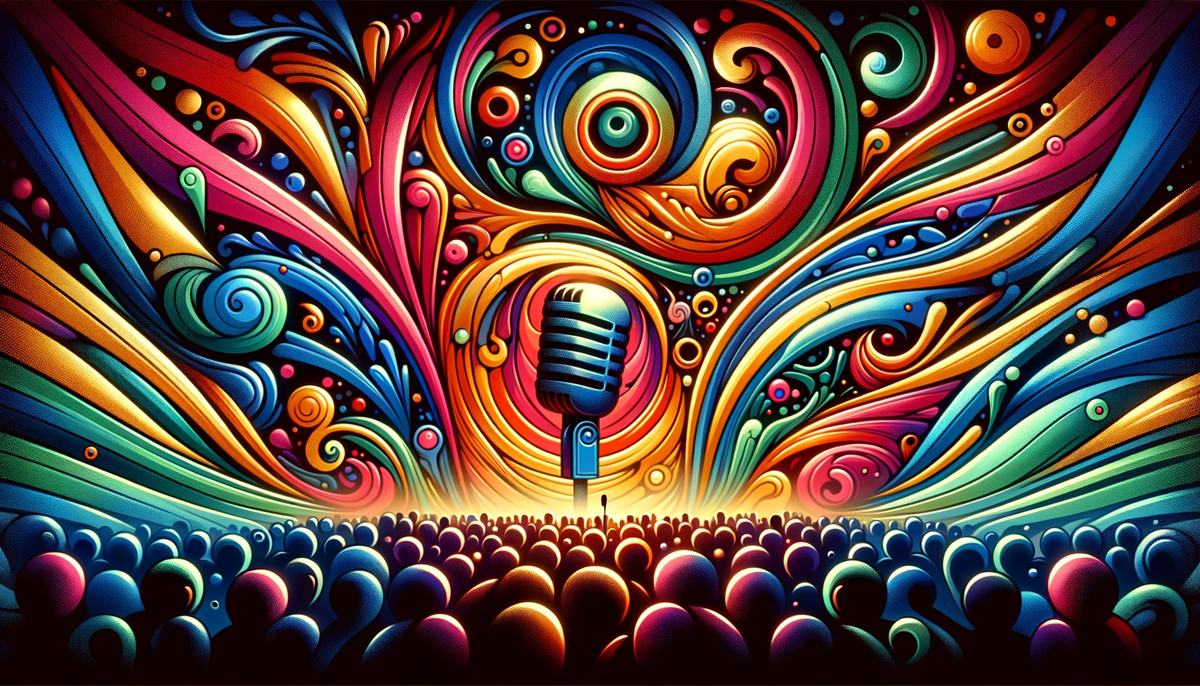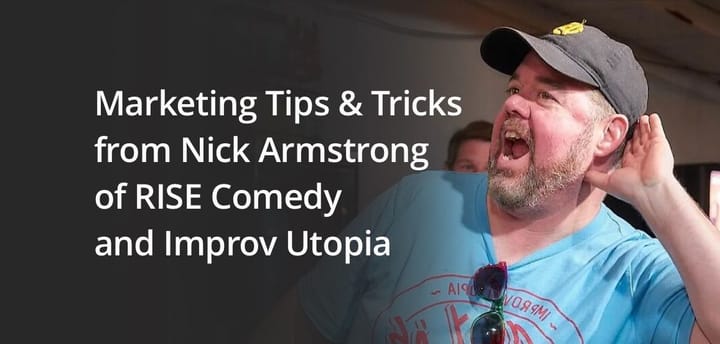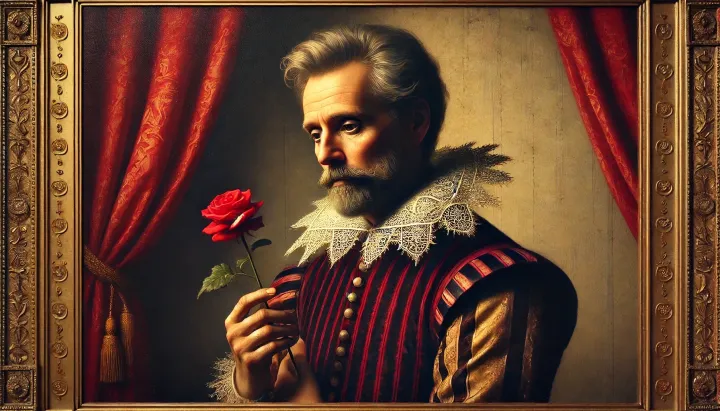A Brief History of Stand-Up Comedy

No one knows when the first joke was told, but it probably went something like this: Gathered around a flickering fire, a caveman tripped over a rock and clumsily spilled his handful of berries. A fellow tribe member, seizing the moment, exaggerated the fall with a playful grunt and an overly dramatic reenactment. The onlookers erupted in what can only be described as prehistoric laughter.
It was a simple, spontaneous moment that captured the essence of humor: the ability to find amusement in the ordinary, make light of life's little misfortunes, and bring people together through shared laughter. His friends encouraged him to tell others, and so the man found himself on a makeshift stage, making his fellow tribesmen gasp for breath between roaring laughs at his words and grunts. And so, in that humble gathering, a timeless tradition was born—one that would evolve through millennia, crossing cultural and linguistic barriers to fill dedicated spaces where laughter reigns supreme: our modern-day comedy clubs.
But really, what was the first-ever punchline? The earliest recorded joke, found on a Sumerian tablet from 1900 BC, is a fart joke. The second oldest joke we know of is an Egyptian one about how to cure a pharaoh’s boredom, a form of political satire. We can rest easy knowing that the roots of comedy are as simple and relatable as laughing at flatulence.
Far removed from the open-air gatherings around ancient bonfires, modern comedy clubs have become hallowed halls of humor where aspiring comedians and seasoned pros alike test the boundaries of laughter and social commentary. Yet, the essence remains the same: a lone individual, armed only with wit and timing, captivating an audience through the universal language of humor. Fun fact: The oldest bonafide comedy club in the world of the modern age was Dangerfield’s in New York City. Rodney Dangerfield’s club beat out The Comedy Store in Los Angeles by three years.
It's a social contract similar to that of theaters, a collective agreement to suspend disbelief and allow oneself to be carried away by the rhythms of comedic timing and narrative. Despite its inherent peculiarity, this setup has stood the test of time. It has survived through changing social climates and technological revolutions, evolving from the satirical plays and monologues of ancient Greece to the court jesters of medieval times and from the vaudeville stages to the intimate, dimly lit comedy clubs of today. In an era where digital communication often divides us, comedy clubs are havens for genuine, unmediated human interaction. Here, eye contact, body language, and the live audience's audible reactions are essential to comedy. Is the increasing trend of comedians asking audiences to lock their phones in special signal-blocking bags an acknowledgment of how distracting technology can fragment our attention and societal connections?
Early Comedy as Jesters in Medieval Kingdoms
The jesters of medieval times were often appointed positions, far removed from the open mic nights and comedy clubs that aspiring comedians frequent today. Jesters were not merely entertainers but were considered valuable assets in royal courts. With the unique privilege to speak candidly (known as the jester’s privilege), jesters used humor to deliver news or observations that others in the court would hesitate to express. Jesters were considered trusted advisors, enjoying access to kings, queens, and nobles—a privilege most could never imagine. Their humor mixed satire, wordplay, and physical comedy, frequently interspersed with music or poetry. The jesters' cap and bells, and their marotte (a prop stick) mirrored the crown and scepter used by monarchs. These items symbolized that a jester's words were legally protected.
The jester's role closely prefigures modern stand-up comedians, a link that becomes evident when comparing their functions. Both jesters and comedians use their platforms to critique society, politics, and human behavior creatively, enjoying a degree of freedom in their speech protected by law. In medieval and Tudor periods, jesters, initially called 'minstrels,' were not just entertainers but also served as messengers or morale boosters in battles. The term minstrel was used to describe various entertainers in medieval Europe. Fools were typically diverse in their talents, including singing, playing music, and sometimes performing magic. By the 12th century, some jesters, both men and women, were even granted land for their services to royalty. Although a few achieved fame and wealth, complete with horses and servants, most jesters led less glamorous lives, undertaking various tasks like music, comedy, household errands, and even managing the hounds.
As the Middle Ages progressed, three types of 'fools' emerged: the professional fool, the 'innocent fool' or ‘natural fool’—often people with mental illnesses or physical deformities kept by noble families—and amateur jesters performing at public events. Will Sommers is a famous jester of history, having served as Henry VIII’s court jester until Henry’s death. Despite the risks and hardships of lesser fools, the role of the jester evolved over time, giving way to comic actors on stage and eventually phasing out as a courtly role by the late 17th century. However, the essence of jesting—using humor to comment on society and human behavior—obviously continues to live on in modern comedy. This gradual change spares modern comedians from wartime duties, among other things. Oh, how far we’ve come.
Unlike their medieval counterparts, modern comedians are not bound by allegiance to a single patron. An interesting, yet highly complex aspect of early American theater is the phenomenon of minstrel shows. Regrettably, these shows often featured blackface performances, a practice that is rightly condemned in contemporary society for its perpetuation of racial stereotypes and promotion of racial insensitivity. However, it's important to recognize that these shows also contributed to the early forms of stand-up comedy. They included stump speeches — exaggerated, often nonsensical monologues that highlighted societal issues and racial stereotypes of the less fortunate. While the use of blackface is inexcusable, it is a historical fact that performers of that era used this controversial medium to address provocative and contentious topics under a guise of ignorance and satire. This aspect of comedy's evolution is incredibly complex, intertwining issues of race, humor, and societal commentary in a way that demands a nuanced and careful examination beyond the scope of this article.
Satirists, Vaudevillians, and Early Stand-up in the U.S.
This period also saw the rise of Artemus Ward, the pseudonym of Charles Farrar Browne, who launched his comedic career by publishing the "Artemus Ward" series in The Plain Dealer in 1858, which gained popularity across America and England. Known for his unique and quirky style, characterized by deliberate misspellings, deadpan humor, and folksy wit, Ward captivated audiences with his blend of satire and absurdity. Abraham Lincoln, an admirer of Artemus Ward, even read Ward's latest work to his audience before presenting the Emancipation Proclamation. Artemus Ward is considered America’s first stand-up comic, though some sources also credit this title to Charlie Case. Concurrently, by the early 20th century, Vaudeville theater began to gain significant traction in the public eye, marking a new era in popular entertainment.
The stand-up art form evolved alongside American vaudeville and the Chitlin' Circuit, eventually distinguishing itself by having comedians speak directly to audiences without needing props or costumes. The American Mafia owned the nightclubs from the 1930s to the 1950s, providing the space for stand-up to flourish. The acts that grew well were those of Alan King, Danny Thomas, Martin and Lewis, Don Rickles, Joan Rivers, and Jack E. Leonard, to name a few. Various other entertainment forms, like burlesque, also influenced the stand-up form of comedy.
American humor began to change with the turn of the 20th century to rely on fast-paced jokes and ethnic personas. Key figures from this era, like Moms Mabley, Jack Benny, and Bob Hope, laid the foundation for modern stand-up, which would later be revolutionized by comedians like Lenny Bruce, Mort Sahl, Richard Pryor, and George Carlin, who helped move the needle away from one-liners slapstick and introduced elements of longer form social satire and political commentary. The advent of mass media helped propel the stand-up industry tremendously during this same period.
Stand-up Comedy: A Modern, International Industry
Stand-up comedy saw international growth soon too, with countries like India embracing the form in the 1980s, a period marked by pioneers like Johnny Lever and Raju Srivastava, who blended traditional Indian humor with the emerging stand-up format. In countries like Spain and Brazil, stand-up comedy began appearing in the 1950s and 1960s. However, it wasn't until the late 1990s that these countries established strong stand-up traditions. From the 1970s to the '90s, the medium continued to evolve, shaped by various styles and genres influenced by comedians like Robin Williams, Jerry Seinfeld, and Ellen DeGeneres.
Despite undergoing various economic cycles, including a "comedy bust" in the 1990s, stand-up has not only persisted but thrived. In India, the art form of stand-up comedy evolved with influential figures like Vir Das and Kapil Sharma, who brought fresh and dynamic approaches to Indian comedy. Vir Das, known for his raw and unfiltered style, exemplified this evolution with his November 2021 performance at the Kennedy Center titled "Two Indias." In this monologue, he offered a stark contrast between India's rich and poor, critiqued politicians, and highlighted societal divisions over Bollywood and cricket. The performance, which received a standing ovation, also sparked controversy and led to several police complaints against Das in India, particularly for what some perceived as insulting the nation on foreign soil.
As technology has evolved, it has enabled comedians like Bo Burnhan to reach global audiences directly, bypassing traditional networks by offering content directly on his own youtube channels. This trend among comics was accelerated by the pandemic lockdown, leading to innovative approaches in content recording and distribution. Interestingly, this embrace of technology for distribution coexists with practices like sealing phones in bags during live shows in the now-open venues. As observed during Dave Chappelle's recent near-sell-out show at Amway Center (and all of his shows since 2014), such practices lead to increased audience interaction, harking back to a pre-digital era in live events. Despite the restrictions on phone access, shows like Chappelle's have been financially successful, demonstrating the potential of this blended approach.
Using Yondr pouches, where phones are securely locked, exemplifies how live comedy is evolving with technology. Implementing these measures in large venues requires careful planning, especially for large audiences, but has proven effective in enhancing the live event experience. This system is a novel way to protect the artists' intellectual property while minimizing distractions, ensuring the audience's full engagement. It's a compelling development in stand-up comedy. It shows how comedians safeguard their material in person while leveraging technology to distribute and control their content online, turning themselves into a one-stop shop for their craft. Fun fact: numerous school districts across the country, inspired by comedian Dave Chappelle's use of Yondr phone-locking technology at his shows, have been experimenting with implementations of this technology in classrooms, aiming to enhance student concentration and success.
Today, stand-up comedy stands as a significant cultural force globally, evolving far beyond its vaudeville roots to become a mirror reflecting societal trends and a platform for poignant social critique. Celebrated through prestigious awards like the Mark Twain Prize for American Humor, it not only honors comedic excellence but also acknowledges the profound impact of humor on society. As a dynamic form of expression, stand-up challenges norms, fosters dialogue, and promotes understanding, reaching wider audiences through digital platforms. This goes beyond simple entertainment; it represents a significant influence in the ever-evolving story of human experiences, constantly influencing and being influenced by the cultural and social context of its era.
https://www.historyextra.com/period/medieval/what-was-life-like-for-a-court-jester/
https://www.insider.com/historians-10-oldest-jokes-in-history-1900bc-2019-7
https://www.vulture.com/2011/10/egypts-ancient-comedy-history.html
https://en.wikipedia.org/wiki/Stand-up_comedy
https://en.wikipedia.org/wiki/Charles_Farrar_Browne
https://en.wikipedia.org/wiki/Stump_speech_(minstrelsy)



